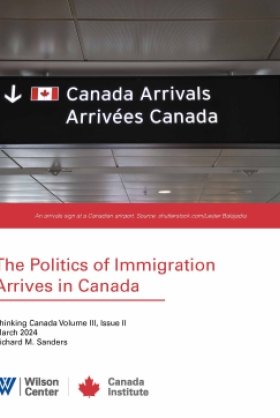New Scholarship in Race and Ethnicity -- Immigration Policies Go Local: The Varying Responses of Governments to Low-Skilled and Undocumented Immigration
Karthick Ramakrishnan, University of California, Riverside, speaker; commentators Roberto Suro, Annenberg School of Journalism, University of Southern California; William H. Frey, Brookings Institution.
Overview
Karthick Ramakrishnan, Assistant Professor of Political Science, University of California, Riverside, speaker; commentators Roberto Suro, Professor of Journalism, Annenberg School of Journalism, University of Southern California; William H. Frey, Senior Fellow, Metropolitan Policy Program, Brookings Institution.
Immigration policy has traditionally been the purview of the federal government. Recently, however, some local governments have taken actions of their own, proposing and in some cases adopting ordinances dealing with immigrants. These have included both anti-immigrant ordinances that, for example, prohibit landlords from renting to undocumented immigrants, require police to check the status of people they stop, or declare English to be the municipality's official language; and pro-immigrant ordinances that create city identity cards for all residents no matter what their status, establish centers for day laborers, and give "sanctuary" to undocumented immigrants.
Prof. Karthick Ramakrishnan, speaking at the 20th program in the Division of U.S. Studies' series on New Scholarship in Race and Ethnicity, asserted that most explanations for the proliferation of such ordinances – rapid demographic changes resulting from mass immigration, concomitant increased competition for low-skilled jobs in areas where there is already substantial poverty, or immigrant political activity viewed as threatening – are unsatisfactory.
Ramakrishnan and a colleague studied the more than 20,000 American municipalities and discovered that by July 2007, fewer than one percent of them had discussed and/or enacted ordinances. Only 55 percent of the proposed anti-immigrant ordinances had been adopted, whereas 74 percent of those categorized as pro-immigrant were passed. Localities where Latinos are a substantial part of the population showed an increased likelihood of restrictionist proposals but an even higher likelihood of pro-immigrant proposals. As cities in which there were strong immigration reform demonstrations in 2006 generated more pro-immigrant than restrictionist proposals, the common understanding of why such proposals are introduced is flawed.
Ramakrishnan suggested that a better explanation lies in adherence to a particular political party. Areas that are strongly Republican are more likely to have restrictionist proposals. A second factor is the size of the locality. Pro-immigrant ordinances are 14 percent more likely to be enacted in larger cities than in smaller localities, while anti-immigrant ordinances are only five times as likely to be passed. At the same time, municipalities that are largely dependent on agriculture are less likely to pass such ordinances.
Roberto Suro commented that local political activity in this area is frequently a reaction to national or international phenomena. People tend to react to what they see happening to the country as a whole. The most potent negative reaction to the 2006 immigration demonstrations occurred in places that did not experience the protests but clearly viewed them as shaping the future of the country as a whole. Suro noted as well that the primary locus of non-federal immigration policy-making occurs at the state level, not that of the municipalities. In 2006, 57 bills pertaining to immigration were introduced in state legislatures; in 2007, the number rose to 1,562. A total of 240 became law. The question therefore becomes whether state action preempts local action and may account for a lack of local ordinances.
Suro questioned the partisanship thesis, as public opinion surveys show that voters in both parties are split on the immigration issue. Immigration has never been a red state/blue state issue, he asserted; the most restrictive recent immigration measures were adopted during the Clinton administration. He agreed with Ramakrishnan that locality size matters. Immigrants can be seen as a drain on public resources, which is a greater threat in less-wealthy smaller cities and suburbs than in larger cities with greater resources. Most importantly, in areas where citizens experience a sense of helplessness and loss of identity in an age of increasing globalization and homogenization, they may turn immigrants – highly visible symbols of change – into whipping dogs.
William Frey noted that collecting data on proposed local ordinances is a difficult task, with scholars overly dependent on accounts in the media. Congratulating Ramakrishnan on the most ambitious study of local ordinances that Frey has seen and on identifying the partisan variable, he noted that further examination is needed of the importance of the Latino immigrant population being primarily low-skilled. The type of locality – city, county, suburb or exurb – may also be a determinant. Frey presented research showing that only 13.4 percent of likely voters list illegal immigration as a major concern today. Asked whether illegal immigration is a big problem, however, 50 percent of white likely voters (and 60 percent of those with only a high school education) replied that it is. This is particularly true in states that are not traditionally immigrant-receiving but have received large new immigrant populations. At the same time, only 43 percent of likely white voters and 21 percent of likely African-American voters feel strongly that immigration is a good thing for this country. Fifty-one percent of white college graduates feel this way; the percentage drops to 32 percent of those with a high school education or less. The question of immigrant political power and the reactions it may cause, Frey warned, may become a critical determinant of political decisions by the year 2012.
Drafted by Acacia Reed and Philippa Strum
Philippa Strum, Director, Division of U.S. Studies 202-691-4129
Documents & Downloads
- New Scholarship in Race and Ethnicity -- Immigration Policies Go Local: The Varying Responses of Governments to Low-Skilled and Undocumented ImmigrationDownload
- New Scholarship in Race and Ethnicity -- Immigration Policies Go Local: The Varying Responses of Governments to Low-Skilled and Undocumented ImmigrationDownload
Thank you for your interest in this event. Please send any feedback or questions to our Events staff.










